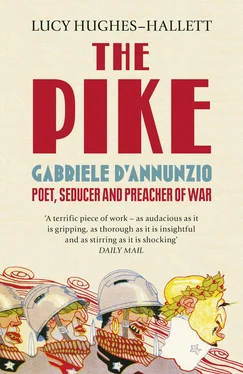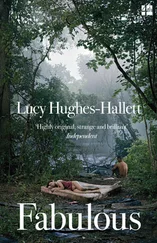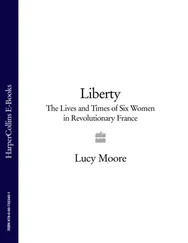NOBILITY
ONE SUNDAY MORNING in May 1879 a troop of the Cicognini boys, preceded by the school band, marched in military order from Prato to Poggio a Caiano, some ten kilometres distant. They stopped for a picnic breakfast of bread, salami and wine in a park en route and picked between them an immense bunch of daisies. Somehow (because that was the kind of boy he was) it fell to Gabriele d’Annunzio to present the bouquet to the head teacher’s wife.
With flowers in their buttonholes and their cap bands, the boys marched on into Poggio. They were met by another band from the town, and, with shouts of ‘Long Live the King!’ they proceeded on to the Villa Medici, built by Giuliano di Sangallo for Lorenzo the Magnificent, and by this time a (seldom-used) royal residence.
D’Annunzio was enraptured. Here was a setting for the kind of life he dreamed of. ‘Great rooms painted with flowers and adorned with immensely valuable paintings: elegant and mysterious bedrooms; and everywhere a profusion of lamps, of mirrors, of carved chests, of marble tables, and over all something entrancingly venerable and ancient.’ He hung back as the other boys hurried out into the gardens. For a quarter of an hour he stayed alone in the frescoed salon that Vasari once called the most beautiful room in the world, indulging in a reverie that was part erotic fantasy, part awed contemplation of the glamour and grandeur of the Italian aristocracy. ‘I seemed to hear the rustle of Bianca Capello’s silk dress, to hear her yielding sighs and sweet words.’ Bianca Capello was a sixteenth-century beauty whose portrait by Allori d’Annunzio could have seen in the Uffizi. She and her Medici lover died mysteriously on the same day in 1578, probably poisoned by his relatives. D’Annunzio was thrilling himself with a tale of murder and forbidden passion. Any moment, he told himself, he might see a knight in armour, ‘his eyes flaming behind his visor, his sword unsheathed’.
The boys ate their lunch al fresco and went boating, but then it began to rain. An arched colonnade runs all around the villa at ground level. The boys took shelter there, and began to dance. It was a jolly scene, but for d’Annunzio, as precocious sexually as he was intellectually, it lacked a certain something. He had been eyeing the major-domo’s three daughters. He slipped into the house ‘for a glass of water’, and asked the prettiest of the trio if she would dance with him – ‘Just one waltz?’ She assented. They passed into the great salon. Soon some other boys joined them. ‘So we had a real dancing party … a bacchanal.’ He was twirling over the floor where Lorenzo the Magnificent had once trod, between walls decorated by some of the most revered artists of Italy’s golden past. ‘I enjoyed myself,’ the sixteen-year-old d’Annunzio told his mother; ‘very much; perhaps even very, very much.’
As a child in Pescara, d’Annunzio was a person of consequence, the mayor’s eldest son, living in one of the best houses in town. At the Villa Fuoco, the family’s country retreat, there were wide balustraded terraces, with stone pilasters topped by terracotta pots in the shape of the busts of kings and queens, their crowns formed by living aloe plants. When his father’s profligacy obliged the family to sell some land Gabriele watched the peasants, their dependants, crowding around his mother, as though around a queen going into exile. People brought offerings, a branch laden with apricots, a carafe of wine, a lamb. ‘Some of them knelt to kiss the hem of her dress. Others kissed my hands, bathing them with tears.’ Gabriele grew up with an expectation of deference. He would play with other children, but one of them later recalled that if anyone tried to question his leadership, ‘he would fire up, his face went red and three veins would swell visibly on his forehead’. At home in the Abruzzi he seldom met anyone to whom he felt socially inferior.
In Rome things were different. Later he was to write that the human race was divided into those superior beings who had the leisure and the capacity to think and feel and, on the other hand, those who must work for their living. He never doubted that he belonged by nature to the first class, but circumstances, to his great chagrin, consigned him to the latter. He was a hired scribbler, a hack. He couldn’t make enough by selling his poems alone. Soon, as well as reviewing books and music and exhibitions, and writing about shops and cafés and the best way to incorporate the newly fashionable Japanese knick-knacks into the décor of a European drawing room, he had become a gossip columnist, the kind of social parasite the snobbish narrator of Henry James’s Daisy Miller (James was also living in Rome at the time) calls a ‘penny-a-liner’.
Seven years after he arrived in Rome, d’Annunzio took himself off to Francavilla, and there, in six months, wrote his immensely successful first novel Pleasure. It recounts the amorous adventures of Andrea Sperelli, Count Ugenta. He loves first Elena Muti, a young widowed duchess, beautiful, wilful and depraved, who first signals her availability by asking Sperelli to buy her an enamelled death’s-head, and who loops her feather boa around his neck in a closed carriage and draws him wordlessly into her dangerous embrace. Abandoned by Elena, and vulnerable after being wounded in a duel, Sperelli subsequently falls in love with Maria Ferres, equally beautiful but high-minded and pure-hearted, a gifted pianist who succumbs to Sperelli’s seduction only after protracted hesitations and is ruined by him.
Into the novel went observations d’Annunzio had been recording as a journalist throughout those seven years. He describes a race meeting, a charity auction, a concert, the bustle around the antiquarian jewellers’ shops in the Piazza di Spagna. All these were venues where a writer obliged to work for his living could stand alongside the members of the otherwise so inaccessible upper classes. The great d’Annunzio scholar Annamaria Andreoli has noted the poignancy of the fact that Elena Muti is first seen from behind and below, as she mounts the steps of the palace where she is to dine. D’Annunzio, newly arrived in Rome, was the outsider on the pavement, watching those more privileged going through doors he was not invited to enter. And even when some of those doors began to open to him, they did so, not as to a welcome guest, but to a barely tolerated reporter.
The nobility were everywhere visible in Rome, even to those who would never get to know them. D’Annunzio saw carriages driving up and down the Corso, ladies lying back in them, heavily veiled and lapped in furs. In Spillman’s cake shop he listened in on a pair of princesses chatting ‘indolently’ as they bought bonbons, and noticed their headgear: ‘a tiny hat of black lace’; ‘an aigrette of ostrich plumes and heron feathers’. He went to the races and stood among the crowd, composing verses to the ‘goddesses’ in the stands: to the ‘unknown blonde Diana’ with the ‘hippopotamus husband’, whose marble-white arms were loaded with gold bracelets and half concealed by flower-patterned tulle; to the Amazon in the green dress and the red-plumed hat. At the opera he sat in the stalls and gazed up at the ladies in the boxes, taking fashion notes for his column. The Princess di San Faustino, in a ‘dress of palest blue, shading into sea green, flowing, almost transparent … over her bare shoulders a blonde beaver fur, trimmed with red satin … a half-moon of brilliants glittering on her high-piled hair’. The Countess Chigi-Londalori in white satin, ‘slender as the stem of a lotus’. The Princess di Sciarra and the Duchess di Avigliana, both in black brocade. The Countess Antonelli in a tight dress of turquoise-striped silk. And so on and so forth. Day after day, week after week, he poured out these lists of names and jewels and textiles, caressingly itemising the physical attributes and expensive accessories of women he didn’t know.
Читать дальше












